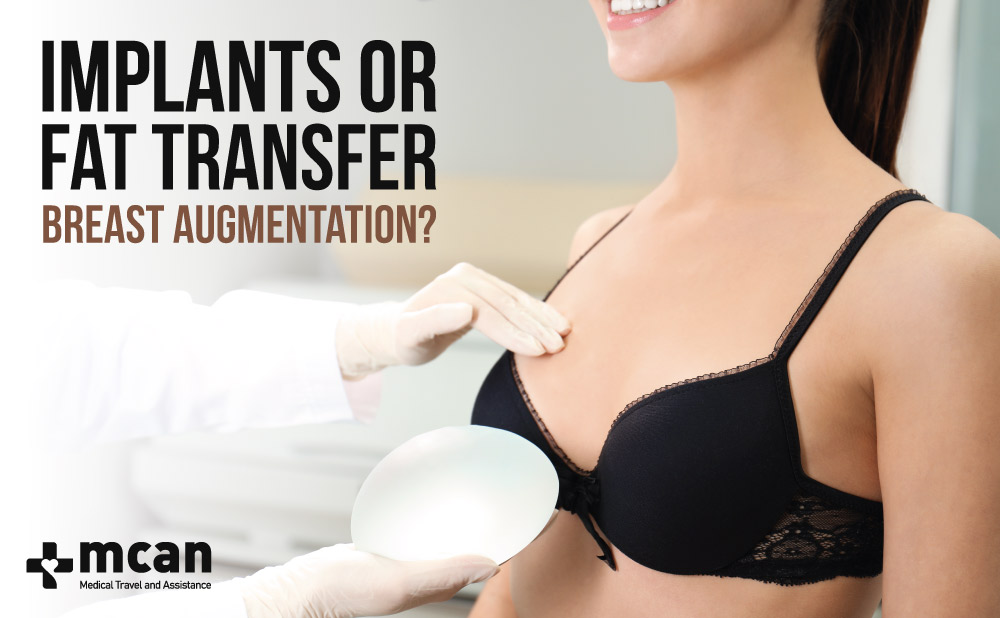
Breast enhancement is a popular procedure for those looking to boost their confidence and improve their appearance. Two common methods are breast implants and fat transfer.
While both aim to increase the size and improve the shape of the breasts, the techniques, materials used, and outcomes vary significantly. Understanding these differences can help you choose the right option based on your needs and aesthetic goals.
In this article, we’ll break down how each procedure is performed, the recovery process, cost comparisons, and the pros and cons to help you decide which option is right for you.
How is Breast Augmentation Done with Fat Transfer?
Fat transfer, also known as autologous fat grafting, is a minimally invasive and natural approach to breast augmentation. Here’s how it works:
- Step 1: Liposuction: Excess fat is removed from areas like the abdomen, thighs, or flanks, providing a body contouring benefit in addition to breast enlargement.
- Step 2: Purification: The harvested fat is purified to remove impurities.
- Step 3: Injection: The processed fat is carefully injected into the breasts to achieve subtle, natural-looking breast expansion.
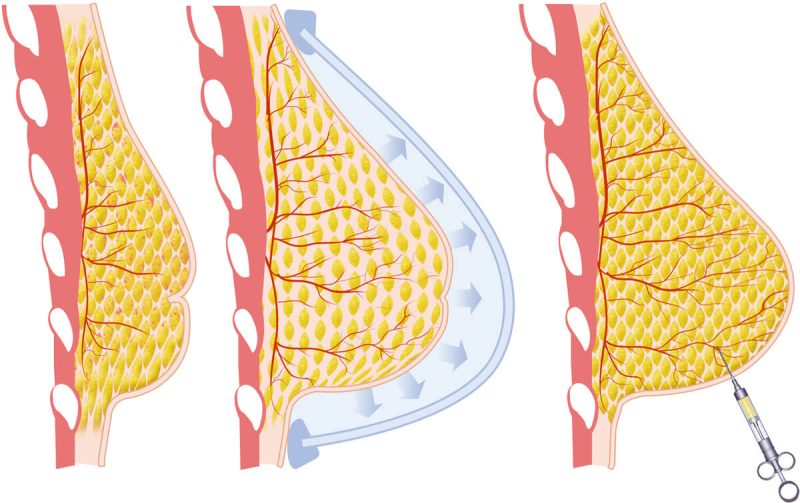
Fat transfer offers the advantage of dual enhancement, as it not only provides breast augmentation but also contours the body by removing unwanted fat from areas like the abdomen or thighs. Additionally, this method delivers natural results without the use of synthetic materials, making it appealing to those who prefer a more organic approach.
However, results can vary based on how well the transferred fat is retained by the body. This procedure is best suited for women who are looking for a modest size increase rather than a dramatic change.
How is Breast Augmentation Done with Implants?
Breast implant surgery is a well-established method that provides more significant and customizable results for those seeking dramatic breast expansion. The process includes:
- Step 1: Incision: An incision is made in one of three common locations: under the breast crease, around the areola, or in the armpit.
- Step 2: Implant Placement: The implant, either silicone or saline, is inserted behind the breast tissue or under the chest muscle.
- Step 3: Closure: The incisions are carefully closed to minimize scarring.
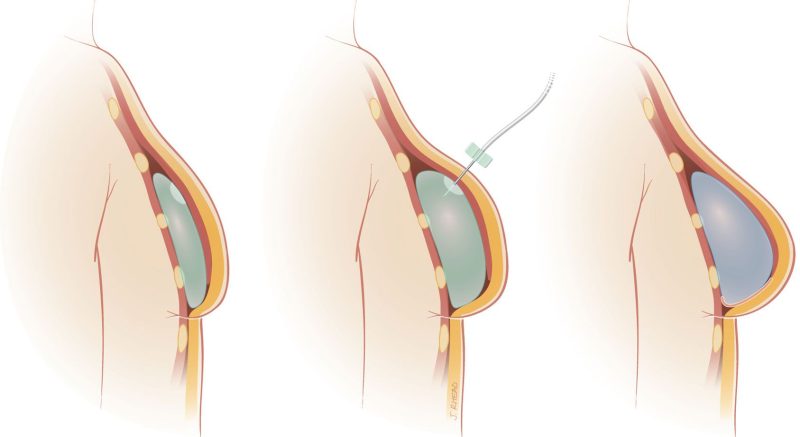
Breast implants offer customizable options, coming in various shapes like round or teardrop, as well as different sizes and profiles to achieve your desired level of breast enlargement, making them suitable for women seeking a more dramatic augmentation. During recovery, wearing a surgical bra is essential, as it helps support and properly position the implants for optimal results.
Key Differences Between Fat Transfer and Implants
While both procedures aim to enhance the breasts, the differences in technique, recovery, and results make them suitable for different preferences and needs.
| Aspect | Fat Transfer | Breast Implants |
|---|---|---|
| Technique | Liposuction followed by fat injection | Insertion of silicone or saline implants |
| Procedure Time | 3-5 hours (liposuction and transfer) | 1-2 hours |
| Materials Used | Patient’s own purified fat | Medical-grade silicone or saline |
| Scarring | Minimal scarring from small incisions | Potential scarring at incision sites |
| Recovery | 1-2 weeks for bruising to subside | 2-3 weeks for initial recovery |
| Results | Natural and subtle enhancement | Predictable and significant increase |
| Longevity | Results may change with weight fluctuations | Long-lasting, may need replacement over time |
| Suitability | Ideal for subtle increases | Suitable for dramatic size changes |
What to Expect During Recovery
Recovery experiences vary between fat transfer and implant procedures. Each procedure has unique recovery needs. Fat transfer involves healing in both the donor and breast areas, with some initial fat reabsorption expected as part of the body’s adjustment.
Implant recovery, however, focuses more on the chest area, where tissues adapt to the implant. Understanding these differences helps in preparing for the recovery journey, with specific tips available for managing discomfort and promoting optimal healing.
Fat transfer recovery is relatively less invasive, with most patients experiencing bruising and swelling at the liposuction sites and minor discomfort in the breasts. Typically, you can return to normal activities within a couple of weeks, although full results become visible after a few months as the body adjusts to the redistributed fat.
Breast implant surgery recovery involves more significant swelling and tightness in the chest area. Patients are advised to refrain from strenuous activities for up to six weeks, and wearing a supportive surgical bra is essential to aid the healing process. The final outcome is noticeable after a few months once the implants settle.
In addition to understanding the general recovery process, it’s essential to follow specific breast surgery aftercare to support healing and achieve the best results.
Proper aftercare is key to a smooth recovery and enhances the aesthetic outcome. This includes wearing recommended support garments, caring for incisions to prevent infection, and gradually resuming normal activities as advised.
Regular follow-up appointments help monitor progress, and MCAN Health’s support team is available to assist with any questions or concerns, making sure you feel fully supported throughout your recovery journey.
Longevity and Maintenance
The longevity of results varies based on the method chosen. Breast implants are long-lasting but not permanent. They typically last around 10-15 years, and after this period, they may need to be replaced or checked to ensure they remain in good condition. It’s important to have regular check-ups, like MRI or ultrasound screenings, to catch any issues early, such as implant rupture or hardening (capsular contracture).
Fat transfer results can last a lifetime if the transferred fat cells survive and integrate well into the breast tissue. However, keeping these results stable can be tricky. Weight changes can affect the size and shape of your breasts since the fat cells expand or shrink if you gain or lose weight. To maintain your desired appearance, it’s crucial to keep your weight steady.
Comparing Costs: Fat Transfer vs. Breast Implants
When looking at the costs of breast augmentation, it’s essential to think beyond the initial price and consider the long-term expenses involved with each option. Both methods may require follow-up care and additional investments over time to maintain the desired results.
Fat Transfer
- Generally more expensive upfront due to the complexity of the procedure.
- Involves additional steps, including liposuction and fat purification.
- Offers the added benefit of body contouring from the areas where fat is harvested.
Breast Implants
- Lower initial cost compared to fat transfer.
- It may incur extra expenses over time, including replacement surgeries typically needed every 10-15 years and regular monitoring, such as imaging, to ensure implant integrity.
Fat Transfer and Breast Implants: Pros & Cons
Both fat transfer and breast implants come with their own set of advantages and disadvantages. Here’s a detailed breakdown to help you decide which method aligns best with your needs.
Advantages of Each Option
Each option for breast augmentation offers unique advantages that cater to different aesthetic goals and preferences. Here’s a look at the specific benefits of both fat transfer and breast implants to help you decide which method might be the best fit for you.
| Aspect | Fat Transfer | Breast Implants |
|---|---|---|
| Natural Results | Feels and looks more natural, as it uses your own fat. | Predictable size and shape, with reliable, consistent volume and contour. |
| Dual Benefits | Increases breast size while contouring areas with liposuction. | Highly customizable with a wide range of sizes, shapes, and profiles. |
| Minimal Scarring | Small incisions result in less visible scarring. | Immediate, noticeable volume increase right after surgery. |
| No Foreign Material | Lower risk of rejection or allergic reactions, as no synthetic materials are used. | High projection for prominent cleavage and increased volume. |
Potential Drawbacks to Consider
While both fat transfer and breast implants can deliver impressive results, there are also important considerations to keep in mind for each approach. Understanding the potential drawbacks can help you make a well-informed decision and choose the option that aligns with your lifestyle and expectations.
| Aspect | Fat Transfer | Breast Implants |
|---|---|---|
| Limited Size Increase | Best suited for subtle enhancements; not ideal for dramatic size changes. | Potential for complications such as rupture, deflation, or capsular contracture (hardening). |
| Fat Reabsorption | Some transferred fat may be absorbed by the body, potentially reducing volume over time. | Scarring at incision sites, though generally strategically placed to minimize visibility. |
| Multiple Sessions | May require more than one procedure to achieve the desired volume. | Implants typically require replacement every 10-15 years. |
| Weight Fluctuations | Changes in body weight can impact breast size as the transferred fat is still natural tissue. | Regular monitoring needed to ensure implants remain intact and free from complications. |
Who is the Ideal Candidate for Breast Augmentation?
Choosing the right method for breast augmentation depends on your body type, desired outcome, and personal preferences.
Fat Transfer:
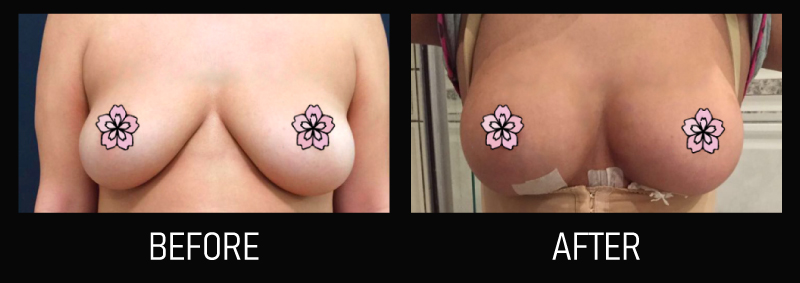
- Best for those seeking a modest, natural enhancement.
- Ideal for individuals with adequate fat deposits and good skin elasticity.
- Suitable for women who prefer a natural-feeling breast enlargement without implants.
- Weight stability is crucial for maintaining results.
Breast Implants:
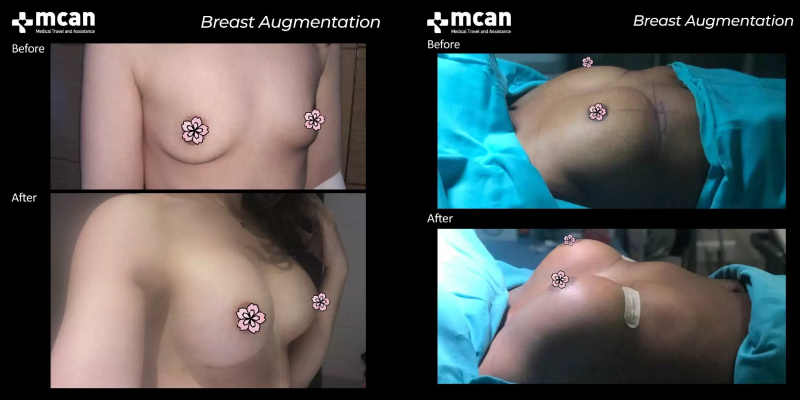
- Suitable for those who want a significant increase in size and more dramatic breast expansion.
- Ideal for women with minimal body fat for transfer.
- Perfect for individuals seeking customizable and predictable breast enlargement results.
- Preparedness for long-term implant monitoring is essential.
To help you visualize potential results, explore our before and after gallery, showcasing real transformations and giving you a clearer picture of what each method can achieve.
How to Choose Between Fat Transfer and Implants
Deciding between fat transfer and breast implants involves considering aesthetic goals, body type, and personal preferences. Each method has its own advantages, and understanding the distinctions can help in selecting the best option for you.
You may be more suitable for Breast Implants if you are:
- Desiring a significant increase in breast size and a more dramatic enhancement.
- Having minimal body fat available for transfer, making implants a more viable option.
- Interested in a highly customizable solution, as implants come in various sizes, shapes, and profiles to meet specific aesthetic goals.
- Prepared for the possibility of needing replacement surgeries every 10-15 years, as implants have a finite lifespan.
- Comfortable with the idea of potential scarring at the incision sites, which can be more visible compared to fat transfer.
You may be more suitable for Fat Transfer if you are:
- Seeking a modest size increase rather than a dramatic change.
- Interested in a natural feel and appearance, as the procedure uses your own body fat.
- Looking to achieve dual benefits, such as breast enhancement along with body contouring from the liposuction area.
- Concerned about scarring, as fat transfer typically results in minimal scarring from small incisions.
- Able to maintain a stable weight, since results can be affected by weight fluctuations.
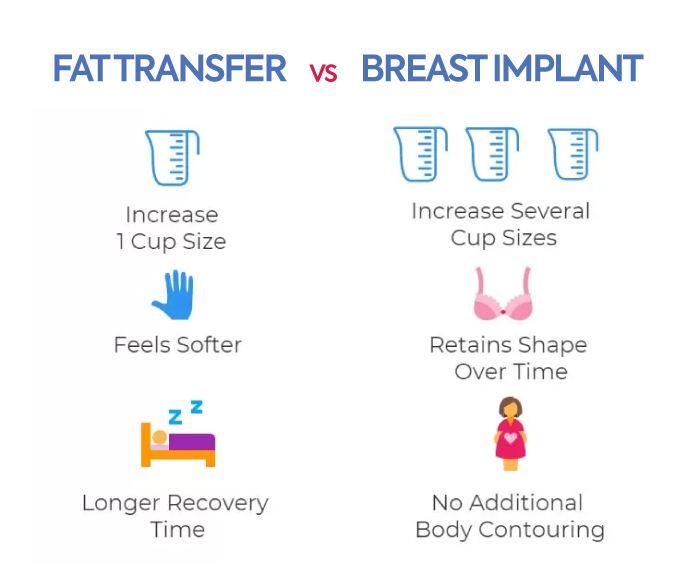
Breast Augmentation in Turkey with MCAN Health
MCAN Health in Turkey is a leading provider of breast augmentation in Turkey, offering both fat transfer and implants. Our internationally recognized surgeons perform surgeries in JCI-accredited facilities, ensuring the highest safety standards.
To hear a firsthand experience, watch this testimonial from one of our breast augmentation patients who shares her journey and results with MCAN Health.
Turkey’s affordability, combined with expert care, makes MCAN Health a top choice for medical tourists.
We offer comprehensive packages, including accommodation, transportation, and personalized aftercare to make your experience stress-free and rewarding.
Our focus on patient satisfaction ensures that you receive the best care, from your first consultation to your recovery.
Frequently Asked Questions
Is It Possible To Combine Fat Transfer And Implants For Breast Enhancement?
Yes, combining both methods can provide natural-looking fullness, especially in cases where implants create volume but additional fat is used to smooth the edges and refine the appearance.
Is Fat Transfer Safer Than Breast Implants?
Both methods have their risks and benefits. Fat transfer avoids implant-related complications like rupture or capsular contracture but carries risks of fat necrosis or absorption. Consulting with your surgeon is essential to understand which option is safer based on your health and goals.
What Happens If I Lose Or Gain Weight After A Fat Transfer Procedure?
Weight changes can affect the volume of transferred fat, leading to alterations in breast size and shape. Maintaining a stable weight is crucial to preserving the results.
Can I Achieve A Significant Size Increase With Fat Transfer Alone?
Fat transfer typically provides a subtle enhancement. If you seek a dramatic size increase, breast implants might be more suitable.
Is Fat Transfer Breast Enhancement More Expensive Than Implants?
Generally, yes. Fat transfer involves a more complex procedure with liposuction and purification. However, the cost difference can be offset by the added benefit of body contouring.
Can Fat Transfer Correct Asymmetrical Breasts?
Fat transfer can be used to correct minor asymmetries, but for more significant differences, breast implants or a combination approach may be necessary.
For more information and to book your consultation, visit MCAN Health today. We’re here to guide you through your breast enhancement journey in Turkey, making your experience as smooth and satisfying as possible.

 What Are The Most Natural Looking Breast Implants?
What Are The Most Natural Looking Breast Implants?  Do I Need a Breast Implants Replacement? How Often?
Do I Need a Breast Implants Replacement? How Often?  4 Things to Know about Mummy Makeover
4 Things to Know about Mummy Makeover